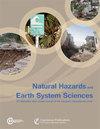印度尼西亚Lembang断层的地震危险性,来自InSAR和GNSS数据
IF 4.7
2区 地球科学
Q1 GEOSCIENCES, MULTIDISCIPLINARY
引用次数: 0
摘要
摘要越来越多的大城市位于人们知之甚少的断层附近,这些断层在最近的历史上没有发生过大地震。伦邦断层是位于印度尼西亚西爪哇万隆市附近的一个这样的断层。该断层的滑动率存在争议,根据GNSS(全球导航卫星系统)活动和地质测量结果,估计滑动率为6至1.95-3.45 mm yr - 1。在本文中,我们测量了万隆地区的地表变形,并利用雷达干涉(InSAR -干涉合成孔径雷达)分析了6年的Sentinel-1卫星数据和连续的GNSS测量数据,解决了兰邦断层的滑动率。我们估计该断层的滑动速率为4.7 mm yr - 1,断层的浅部蠕动速率为2.2 mm yr - 1。以前的研究估计,断层上大地震的复发周期在170-670年之间。假设简化的断层几何形状和对孕震深度的合理估计,我们得出了相当于6.6-7.0级地震的估计力矩赤字,这表明该断层对当地居民构成了非常现实的危险。使用全球地震模型OpenQuake引擎,我们计算了这两种地震情景的地面运动,并估计万隆大都市区内190 - 270万人将暴露在大于0.3 g的地面震动中。这项研究强调了识别活动断层的重要性,了解它们过去的活动,并测量位于地震带大城市附近的较小地壳活动断层的当前应变率。本文章由计算机程序翻译,如有差异,请以英文原文为准。
The seismic hazard from the Lembang Fault, Indonesia, derived from InSAR and GNSS data
Abstract. A growing number of large cities are located near poorly understood faults that have not generated a significant earthquake in recent history. The Lembang Fault is one such fault located near the city of Bandung in West Java, Indonesia. The slip rate on this fault is debated, with estimates ranging from 6 to 1.95–3.45 mm yr−1, derived from a GNSS (global navigation satellite system) campaign and geological measurements respectively. In this paper we measure the surface deformation across the Bandung region and resolve the slip rate across the Lembang Fault using radar interferometry (InSAR – interferometric synthetic aperture radar) analysis of 6 years of Sentinel-1 satellite data and continuous GNSS measurements across the fault. Our slip rate estimate for the fault is 4.7 mm yr−1, with the shallow portions of the fault creeping at 2.2 mm yr−1. Previous studies estimated the return period of large earthquakes on the fault to be between 170–670 years. Assuming simplified fault geometries and a reasonable estimate of the seismogenic depth we derive an estimated moment deficit equivalent to magnitude 6.6–7.0 earthquakes, indicating that the fault poses a very real hazard to the local population. Using the Global Earthquake Model OpenQuake engine we calculate ground motions for these two earthquake scenarios and estimate that 1.9–2.7 million people within the Bandung metropolitan region would be exposed to ground shaking greater than 0.3 g. This study highlights the importance of identifying active faults, understanding their past activity, and measuring the current strain rates of smaller crustal active faults located near large cities in seismic zones.
求助全文
通过发布文献求助,成功后即可免费获取论文全文。
去求助
来源期刊
CiteScore
7.60
自引率
6.50%
发文量
192
审稿时长
3.8 months
期刊介绍:
Natural Hazards and Earth System Sciences (NHESS) is an interdisciplinary and international journal dedicated to the public discussion and open-access publication of high-quality studies and original research on natural hazards and their consequences. Embracing a holistic Earth system science approach, NHESS serves a wide and diverse community of research scientists, practitioners, and decision makers concerned with detection of natural hazards, monitoring and modelling, vulnerability and risk assessment, and the design and implementation of mitigation and adaptation strategies, including economical, societal, and educational aspects.

 求助内容:
求助内容: 应助结果提醒方式:
应助结果提醒方式:


